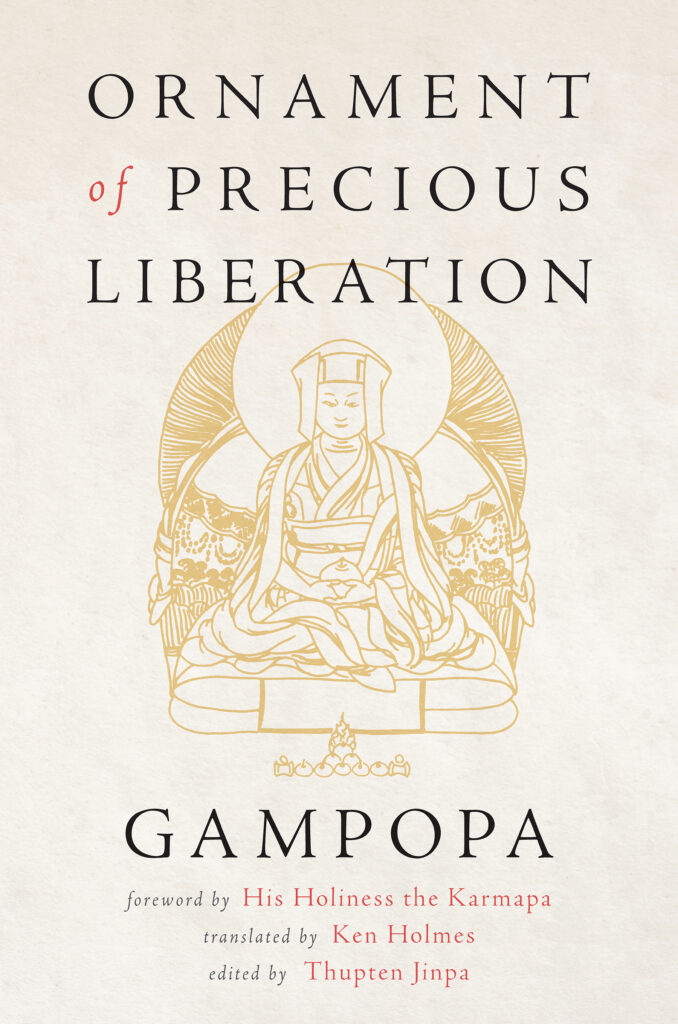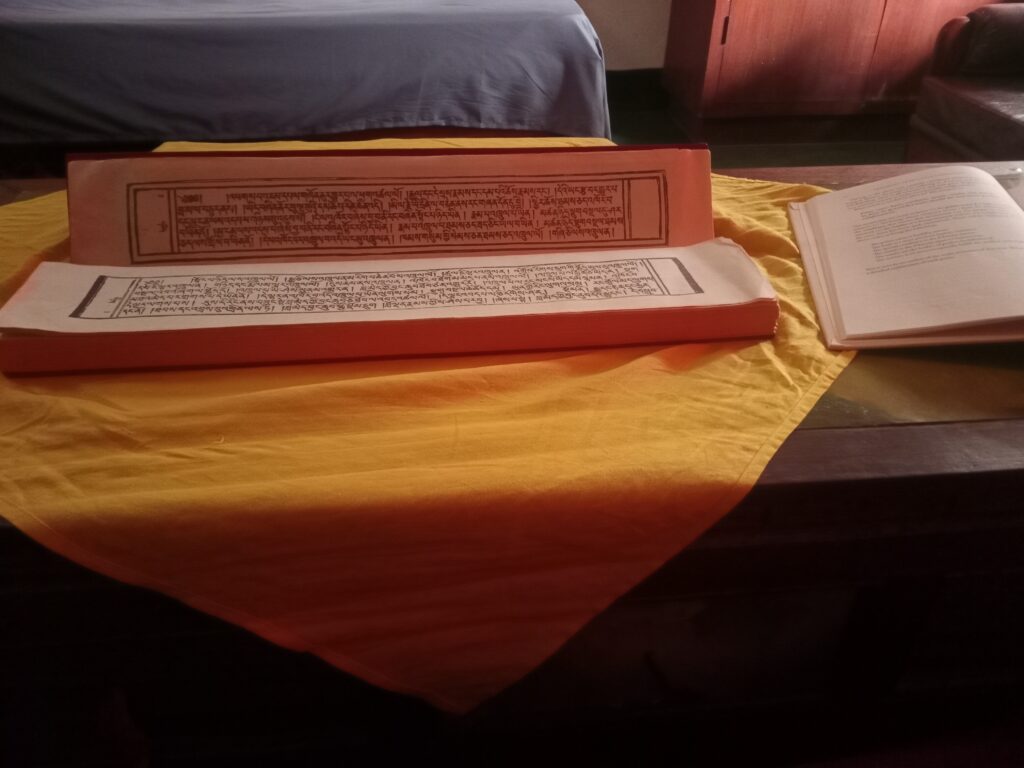At the very beginning of the Ornament of Precious Liberation, Lord Gampopa writes, in Tibetan:
སྡོམ་ནི། རྒྱུ་དང་རྟེན་དང་རྐྱེན་དང་ནི། །ཐབས་དང་འབྲས་བུ་ཕྲིན་ལས་ཏེ།
།བླ་མེད་བྱང་ཆུབ་སྤྱི་སྡོམ་དྲུག །བློ་ལྡན་རྣམས་ཀྱིས་ཤེས་པར་བྱ།
In the beautiful translation of Ken Holmes, edited by Thupten Jinpa-la, this reads in English as follows:
“The synopsis is:
Prime cause, basis, condition, means, results, and activity: by these six general key terms should the wise know peerless enlightenment.”

Through the Ornament of Precious Liberation, Gampopa offers these synopses, in Tibetan called སྡོམ་ཚིག (pronounced something like: Dom Tshig). For centuries, dharma practitioners, especially (monastics) in the Kagyü tradition, have memorized these as little gateways to (remember) the details of the subjects taught by Gampopa.
(re-)discover and read unlike other books
This opening synopsis presents the various chapters of the text, except that the fourth – the means – is spread out over sixteen different chapters. Carefully considering the world as it appears to us and the personal situation we seem to find ourselves in, we should not waste our time and, from this moment onwards, strive to attain unsurpassable enlightenment for the benefit of all sentient beings. These six points point out what we need to know to strive so, each being explained in detail in what follows this outline of the text.
In his foreword, His Holiness the Seventeenth Karmapa Ogyen Trinley Dorje writes:
“We should consider reading Gampopa’s Ornament of Precious Liberation as unlike reading other books. This text has the power of a direct transmission from master to student. Gampopa himself promised that in the future those who were unable to meet him personally should not despair, because reading his two texts Ornament of Precious Liberation and Jewel Garland of the Supreme Path would be identical to receiving the teachings directly from him.”
Furthermore, His Holiness writes,
“The Ornament of Precious Liberation is our great family treasure and our shared inheritance. It is my aspiration that through this text the different traditions of the Dakpo Kagyu will rediscover their common ancestry and become a joyous and harmonious family once more.”
Thus, as a practitioner of the buddhadharma in general, and being a novice monk in the Karma Kagyü lineage, I feel very fortunate to have the opportunity to study and contemplate Lord Gampopa’s word (in Tibetan) under the guidance of my teachers and learn how to follow through in everyday actions of body, speech, and mind. Like His Holiness the 17th Karmapa, Acharya Lhakpa Tshering-la shared that this text is considered like an instruction that becomes only meaningful if we put it into practice.
Given the above, I also feel a tremendous and sometimes daunting responsibility. While my daily schedule does not always allow me to dedicate a lot of time to this (and the schedule of my teachers even more so), it is my aspiration to listen carefully and directly to Gampopa’s teachings, put them into practice with the help of my teachers, and to make a contribution towards His Holiness the 17th Karmapa’s aspiration, even if just a little.

Nalandabodhi Netherlands Online Study Group: Putting Gampopa’s Ornament of Precious Liberation into Practice
When some of my dharma friends of Nalandabodhi in The Netherlands heard that this text was part of my current studies and practice, they asked whether I could guide an online study group. Initially, there was a bit of hesitancy because of just starting to take my first steps on the path, especially regarding this text. Yet, while somewhat daunting, it also feels like a great honor to study together with others interested to see how we can put Gampopa’s Ornament of Precious Liberation into practice, by looking at this text together, contemplating the meaning, and exploring the instructions of Gampopa for our own lives.
So, following some encouragement, I will start to guide an online study group hosted by Nalandabodhi Netherlands from September 24 (2024) onwards on a bi-weekly basis. If you are interested, you can learn more here.
Weaving together Kadampa and Mahāmudrā, and dedication
During this time, it is also my aspiration to share every now and then more from Gampopa’s teachings and, in that way, pass on some of the guidance offered by the sutra tradition of the Kadampa and Mahāmudrā that Gampopa received from the great yogi Milarepa, coming from Nāropa and Maitripa. Part of the genius of the Lord Gampopa, His Holiness the 17th Karmapa notes, was to bring together these seemingly conflicting traditions and wove them together into a seamless path to liberation.
May whatever merit there is in these notes be of benefit and help all beings strive towards supreme enlightenment as instructed by Gampopa. If doing so with great effort, Gampopa points out in the very first chapter, we cannot fail to reach enlightenment.
Why? For that, I would say, you will have to listen to Gampopa himself directly.
དགེའོ། དགེའོ། དགེའོ།
Leave a Reply